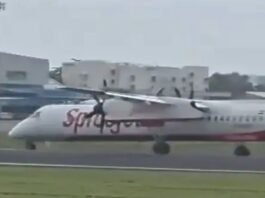
Key Points
- SpiceJet SG670 experienced engine technical snag during descent to Kolkata on November 9, 2025
- All 188 passengers and crew members landed safely at 11:38 PM with no injuries reported
- Emergency services including fire and rescue teams were on standby during landing
- Aircraft is under technical examination by SpiceJet engineering teams
- Incident follows recent Air India emergency landings in Bhopal and Mongolia
- Air India Flight 171 crash in Ahmedabad on June 12, 2025, killed 241 of 242 people aboard, intensifying safety concerns
Mumbai: SpiceJet flight SG670, operating from Mumbai’s Chhatrapati Shivaji Maharaj International Airport to Kolkata, experienced a critical engine malfunction late Sunday night, November 9, 2025, forcing the pilot to declare a full emergency. The aircraft was carrying more than 188 people, including passengers and crew members, when the technical issue occurred during the descent phase of the flight.
According to Kolkata airport officials quoted by news agency ANI, the aircraft’s crew alerted air traffic control after detecting a failure in one of the engines while approaching Kolkata. The pilot noticed the engine behaving abnormally just before starting the descent and immediately informed Air Traffic Control (ATC). Airport authorities quickly mobilized emergency services, placing fire and rescue teams on high alert as the aircraft made its approach.
The plane touched down safely at Netaji Subhas Chandra Bose International Airport at approximately 11:38 PM, and the full emergency status was withdrawn immediately after landing. An airport official confirmed to ANI, “The flight landed safely, and the full emergency was withdrawn at 23:38”. All passengers and crew disembarked normally without any reported injuries, and emergency protocols were successfully executed.
Passenger Panic and Relief
Passengers aboard the flight reported experiencing intense fear and anxiety when they learned of the engine failure mid-flight. The atmosphere inside the aircraft became momentarily panicked as crew members prepared everyone for the emergency landing procedures. Despite the tense situation, the professional handling by the pilots and cabin crew helped manage passenger concerns during the critical moments.
After the safe landing, passengers expressed overwhelming relief and gratitude to the flight crew for their skillful management of the emergency. Eyewitnesses reported that while all passengers were extremely nervous and scared during the incident, they breathed a collective sigh of relief once the aircraft touched down safely on the runway.
SpiceJet’s Official Response
In a statement released early Monday morning, SpiceJet acknowledged the technical issue but emphasized the safe outcome of the incident. “On November 9, SpiceJet flight SG 670 operating from Mumbai to Kolkata experienced a technical issue during descent at Kolkata airport. The aircraft landed safely and all passengers and crew deplaned normally,” said a SpiceJet spokesperson.
The airline did not provide specific details about the nature of the engine malfunction but confirmed that the affected aircraft has been grounded and is currently being examined by engineering teams. SpiceJet has not yet announced when the aircraft will return to service or what caused the engine failure.
Growing Pattern of Aviation Incidents
The SpiceJet emergency landing represents the latest in an alarming series of aviation incidents affecting Indian carriers in recent weeks, raising significant concerns about air travel safety across the country. Just two days earlier, on November 7, several airlines, including Air India, IndiGo, and SpiceJet, had issued advisories alerting passengers about possible delays following disruptions in flight operations at Delhi’s Indira Gandhi International Airport. At least 100 flights were delayed that day following a technical issue involving a malfunction in the Air Traffic Control system.
Approximately one week before the SpiceJet incident, an Air India flight operating from Delhi to Bengaluru was forced to make an emergency landing in Bhopal due to a technical problem. Around the same period, Air India flight AI174 from San Francisco to Delhi made a precautionary landing at Mongolia’s New Ulaanbaatar International Airport on November 2, 2025, after experiencing a midair technical glitch. The Boeing 777 aircraft successfully landed with all passengers safe, though the incident added to growing concerns about technical reliability.
Air India Flight 171 Tragedy Casts Long Shadow
Public anxiety about aviation safety in India intensified dramatically following the catastrophic crash of Air India Flight 171 on June 12, 2025. The Boeing 787-8 Dreamliner was operating a scheduled passenger flight from Ahmedabad Airport to London Gatwick Airport when it crashed just 32 seconds after takeoff at 13:39 IST.
The aircraft, carrying 230 passengers and 12 crew members, a total of 242 people, lost altitude moments after departure and crashed into a medical college hostel near the airport, causing a massive explosion. The impact and subsequent fire killed 229 passengers and all 12 crew members, with only one passenger surviving the wreckage. On the ground, between 19 and 33 people were killed (reports vary), with 67 others seriously injured.
A preliminary report released on July 12, 2025, by India’s Aircraft Accident Investigation Bureau (AAIB) revealed that the aircraft’s front enhanced airborne flight recorder showed both engines lost thrust after their fuel control switches mysteriously moved from RUN to CUTOFF seconds after liftoff. The investigation has not yet determined what caused the switches to move, and the crash remains under active investigation.
In the aftermath of the disaster, Air India suspended 83 wide-body flights for six weeks to perform government-mandated safety checks on its entire Boeing 787 fleet. The airline began gradually restoring routes in mid-July, with a full recovery planned by October 2025. Air India also announced replacement service between Ahmedabad and London Heathrow from August 1 to September 30, replacing the previously scheduled Ahmedabad-Gatwick flights.
Legal and Regulatory Aftermath
The Air India Flight 171 crash has triggered significant legal action and regulatory scrutiny. Families of victims have filed lawsuits against Boeing and Honeywell, accusing the manufacturers of doing “nothing” despite being aware of potential risks associated with the aircraft. A judge in India’s Supreme Court has insisted that nobody can blame the aircraft’s captain for the disaster, emphasizing the need for a comprehensive investigation into all factors.
Indian courts have also criticized the handling of the crash aftermath, stating that India’s aviation regulatory body acted “irresponsibly” by suggesting through leaks to the media that pilot error had caused the disaster before the investigation was complete. Judges emphasized the importance of maintaining investigative integrity and avoiding premature conclusions that could prejudice the outcome.
Public Demands for Enhanced Safety Measures
Following the SpiceJet incident and the pattern of recent aviation emergencies, Indian citizens have expressed mounting concerns on social media platforms about the state of air travel safety. Many are demanding that the government immediately conduct comprehensive technical inspections and enforce stricter standards for all aircraft operating in Indian airspace.
Aviation experts and passenger advocacy groups are calling for enhanced maintenance protocols, more rigorous pre-flight inspections, and transparent reporting of technical issues. The frequency of emergency landings and technical malfunctions has prompted discussions about whether current safety oversight mechanisms are adequate to protect the traveling public.
While Indian aviation has historically maintained a strong safety record, the recent series of incidents has shaken public confidence and raised questions about aging aircraft fleets, maintenance quality, and regulatory enforcement. As air travel continues to grow rapidly in India, ensuring the highest safety standards remains paramount for both airlines and regulatory authorities.









